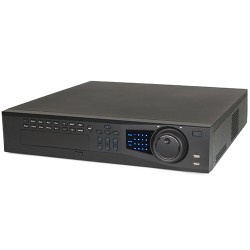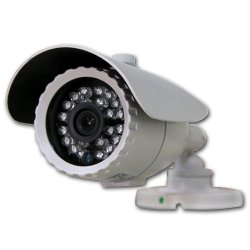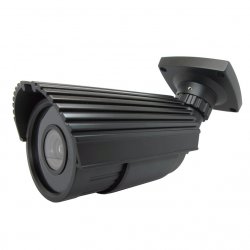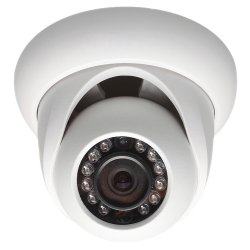 CCTV (Closed Circuit Television): This term once referred specifically to systems that worked like standard television. At the time that the term was coined (the 1960s), the cutting edge was technology that was to eventually become cable television. It used low-frequency waves sent over metal-core and braid cables to connect a video signal with a receiver. However, instead broadcasting in a way that anyone could receive it (also called Open Circuit Television) it would instead only be connected to a single source (thus “closing” the circuit). Today the term is still applicable. All security systems connect from the camera to a recorder. Even though theoretically anyone can “connect” to the signal over the internet, you are still required to have the username and password… This effectively allows the system to prevent anyone who does not belong from “joining” or “connecting” to the signals, and therefore “closes” the circuit off again.
CCTV (Closed Circuit Television): This term once referred specifically to systems that worked like standard television. At the time that the term was coined (the 1960s), the cutting edge was technology that was to eventually become cable television. It used low-frequency waves sent over metal-core and braid cables to connect a video signal with a receiver. However, instead broadcasting in a way that anyone could receive it (also called Open Circuit Television) it would instead only be connected to a single source (thus “closing” the circuit). Today the term is still applicable. All security systems connect from the camera to a recorder. Even though theoretically anyone can “connect” to the signal over the internet, you are still required to have the username and password… This effectively allows the system to prevent anyone who does not belong from “joining” or “connecting” to the signals, and therefore “closes” the circuit off again.
DVR (Digital Video Recorder): This is a term used for all recorders that use a digital format to store video. You can find some that record your cable TV, some that record cameras, and some that record broadcast video information. In context with security, it refers to all recorders that receive information through an analogue broadcast.
NVR (Network Video Recorder): This term is a little more specific. It refers to any video recorder that connects to a computer network to receive and store video information. The video information can come from literally any source including cameras, other recorders, computer storage, and any device enabled to send video in a format the NVR recognizes.
RF (Radio Frequency): This is a term that is used to describe any and all transmissions of information, data, video, audio, etc via an audio or video signal. It is a signal that can be detected by human style audible perception (like terrestrial FM radio).
BNC (Bayonet Neill–Concelman) Connector: This is a standard connector used in RF (Radio Frequency) transmission of all types. It’s named after the two successful inventors that first created it to simplify the joining of two RF circuits.
RCA (Radio Corporation of America) Connector: Once of the most venerable connectors used today. It was introduced by its namesake in the 1940’s to carry audio signal from turntables to amplifiers. A use that it is still used for today.
RG59 or 6 (Radio Guide): The Radio guide is the US Military’s Guide to cables. The number refers to the order the cable was added to the guide, not the qualities of the cable.
RJ-232, 45, 6 (Registered Jack): This system was created by the FCC (Federal Communications Commission) to regulate and standardize the technology being developed in the communications industry. The number is relevant to the order that the configurations of wires were added to the list.
Cat3,4,5,6,7 (Category): This term refers to a rating of cable that is composed of 4 pairs of wire that have been twisted. As the “Cat” number increases, so does the speed at which the cable is capable of transferring data. Several changes factor into the rating/speed increase. All of these changes are determined in the manufacturing process of the cable.
IP (Internet Protocol): This refers to anything “network” oriented. For example; a security camera that connects to a computer network is referred to as a “IP Camera”. Many devices are joining the ranks of “IP” including Printers, Security Systems, Sprinkler Systems, Coffee Makers, etc. As demand increases for “Home Automation”, we’ll find almost every device in our lives assigned to an IP address and remote controllable from our smart phones.
CCD (Closed Coupled Device): This is one of the two most popular types of light-sensing chips in cameras today. It translates light frequencies into a signal usable by a DSP. It is regarded to be the superior chip for poor lighting conditions.
CMOS (Complimentory Metal-Oxide Semi-Conductor): This is one of the two most popular types of light-sensing chips in cameras today. It translates light frequencies into a signal usable by a D
SP. It is regarded to be the superior chip for high resolution requirements.
DSP (Digital Signal Processor): DSPs are the chip “core” of any computerized video process. Essentially the brains and tools for a camera, this chip receives signal from a CMOS or CCD sensor and translates it into a digital format that can be transmitted, compressed, and stored for retrieval at a later time.
GUI (Graphic User Interface): This refers to any software that allows a user to interact with hardware using a video display and devices like a mouse, keyboard, joystick, trackball, or other device.
NTSC (National Television System Committee): This is the format of “standard” television broadcasting created to allow broadcast stations to be available on many different brands and types of televisions. It governs the number of lines and frame a picture is composed of and the general resolution of the picture as well. It is used throughout the Americas and parts of Asia.
PAL (Phase Altering Line): Similar to NTSC, this is the format of “standard” television broadcasting that is accepted throughout the rest of the world where NTSC is not used.
 IR (Infrared): Often misunderstood, Infrared is actually a color. All colors are created by changing the frequency of a beam of white light that is bounced off of an object. The frequency of I
IR (Infrared): Often misunderstood, Infrared is actually a color. All colors are created by changing the frequency of a beam of white light that is bounced off of an object. The frequency of I
R is not detectable by the human eye. In the application of IR in CCTV, simply think of theatrical lighting. If the stage lights are fitted with blue filters and then turned on; everything on the stage appears to be blue. This is exactly how IR works. The lights fitted on cameras emit IR colored light. Thus making objects in front of the camera appear to be “IR colored”. If your camera is able to detect IR light, it will translate the IR color to black and white (colors we can see). The simple truth is, its simply doing the same thing as stage lights. We simply can’t see the color.
HAD (Hole Accumulation Diode): A technology created by the Sony corporation designed to reduce the distortion created by the absence of sufficient light coming in contact with the imaging sensor. It essentially increases low light capabilities.
OSD (On Screen Display): Many cameras have menus to adjust their behavior. These are often set by making selections from a joystick or external control. The menus that pop up when actuated are referred to as the “OSD”.
WDR (Wide Dynamic Range): A feature very important to any application where light and dark zones are simultaneously in the field of view of the camera. The is a digital enhancement that allows the digital iris of a camera to overlap over and underexposed images to provide a single usable picture. It helps compensate for glare and dim areas in images.
ATR (Automatic Tone Reproduction): Another feature for compensating for glare and underexposure. However, unlike WDR, its an enhancement in the DSP, not a compensation of the CCD’s digital iris. Its literally a higher sensitivity to small details of information coming in from the CCD. This version is typically great outdoors, but WDR is often superior inside.
PTZ (Pan Tilt Zoom): These are the three typical ways that a camera can be motorized. Some cameras may have on 1 or 2 of these adjustable axis, while cameras with all three are becoming increasingly more common.
ONVIF (Open Network Video Interface Forum): Not all IP-Video devices can talk to each other. Essentially they all operate and are programmed in different way. The need to “unify and conform” has existed for some time. Several large companies agreed to begin to work together in a unified format somewhat recently. The format is named after the group that created it.
MPEG (Motion Picture Experts Group): The coalition of video experts that develop new formats for video creation, compression, and storage. The technological advances they are responsible for are named after them. The most widely used formats worldwide are theirs, including H.264.
H.264 AVC (High Definition Advanced Video Coding #264, part 10): The most widely used format for recording and compressing video. There are several different “parts” and “versions” that relate to different types of hardware and usage. Essentially they work with varying amounts of efficiency, but all do the same thing.
RS-485 (Radio Standard #485): This is simply a format for broadcasting data over an analogue communication type. It is usually connected via a pair of wires and is the most common method for connecting a PTZ camera or remote OSD connection to a DVR for control purposes.
CIF (Common Intermediate Format): The standard size of a single video image for video and teleconference purposes. This size and format was later adopted by other industries (like security cameras). It’s actual size is 352 x 240 in NTSC terms.
D1 (Digital Format): One of the earliest formats of Digital Imaging. It was created by Sony and Bosch and was replaced with CIF as a more efficient standard. 4CIF is sometimes called D1, but they are slightly (almost undetectably) different in size. D1 is 720 x 480, 4CIF is 704 x 480.
VGA (Video Graphics Array): A display adapter created by IBM designed to be the state of the art in graphics display. It has a display resolution of 640 x 480 and due to advances in technology, has been mostly replaced by the HDMI format…
HDMI (High-Definition Multimedia Interface) and DVI (Digital Video Interface): These are the two current display adapters in use today for High Definition Video transfer from a device to a display unit like a monitor or television. HDMI supports audio and video, where DVI is only for Video Information.
RAID (Redundant Array of Independent Disks): A system of arranging multiple hard drives in a system that simultaneously record. This is found in CCTV systems when it is imperative that footage is stored. Essentially, two drives are used redundantly so that if something happens to one of them, the footage is not lost.
FPS (Frames Per Second): This is the number of pictures taken or displayed in a second. It is said the human eye sees between 24-28 frames (pictures) per second before the perception of pictures is no longer possible.
FTP (File Transfer Protocol): One of the original ways of transferring and storing files on the internet. The idea of “Cloud Storage” is really just a FTP site, except its the next level since programs can be run there as well.
LED (Light Emitting Diode): This is a newer technology light bulb. Its essentially extremely small and efficient. They can be made in visible natural light frequencies and non-visible infrared light frequencies. They’re often placed in clusters on the front of a camera to provide “invisible” illumination when there is no natural light present.
VAC (24) (Voltage Alternating Current): This is a format/type of power delivery for electrical devices. It’s less common in CCTV solutions, but superior in some ways. Because it uses Alternating Current instead of Direct Current, it allows longer distances to be traversed without as much loss.
VDC (12) (Voltage Direct Current): This is a format/type of low voltage power delivery for electrical devices. It’s the most common format in CCTV solutions as its inexpensive to manufacture and provides electric in a format that does not require regulation, as DC devices only draw the amperage they require. The downfall is the distance DC power can travel is lesser than that of AC.
TVL (Television Lines): This is a measurement of the “sharpness” the camera is capable of. If you slice the image captured into tiny slivers, this would be the # of horizontal slivers required to create the image. There will always be more lines vertically than horizontally, but those are not measured due to variances in chip manufactures. It is however always the case that the size of the line is exactly the same as the horizontal size, so the sharpness remains.
AGC (Automatic Gain Control): This is the ability for the camera to adjust on its own to varying intensities and types of light input. Its a highly desired feature for quality cameras
OPLF (Optic Low Pass Filter): This feature can be digital or physical. Essentially, its the ability for a camera to remove certain frequencies of light that can be degrading to a sensors ability to produce useful and accurate images. These frequencies are often the artificial ones created by fluorescent lights, or similar types of light.
EXView: Simply the brand name of Sony’s most recent CCD sensor. Also their flagship.
SuperHAD: Another brand name for a higher end Sony CCD sensor.
Dual-Voltage: The technical term for a device that can be connected to more than one voltage type. In the case of CCTV systems, it often refers to a device that can be powered with 12VDC and 24VAC power. Sometimes in the case of IP devices it also refers to POE.
Power Supply: This is a device that plugs into a wall outlet and converts the standard 110/120 VAC from the wall into a format usable by an electronic device.
Vari-Focal: This refers to an adjustable lens on a camera. They can usually vari with zoom distance (mm range) and focal distance (the sweet spot of clarity).
White Balance: A setting in the camera that allows for adjustment of what “natural white” looks like.
Effio: The brand name for Sony’s newest and most powerful camera DSP.
Resolution: The size of an image created by a camera or recorder.
Quality: The clarity and sharpness of the image created by a camera or recorder (often confused with resolution).
Megapixel: The defining term for images over a million pixels in size (big).
Auto-tracking: The ability for a motorized PTZ camera to lock on and follow a moving object.
Channels: the ports in which cameras are plugged into a DVR
Ports: Digital hallways which data travels through a router, switch, or hub in order to reach another device or destination connected.
Hybrid: A recorder that is both a DVR and a NVR
 Day/Night: The ability for a camera to switch from color mode to black and white for lowlight.
Day/Night: The ability for a camera to switch from color mode to black and white for lowlight.
C-Mount (cs-mount): The type of screw on lock used by CCTV box cameras for their lenses
Lux: A measurement for an amount of light. Often more of an opinion, than a true gauge.
Sens-Up: The ability for a camera to enhance small amounts of light to continue to produce usable images digitally.
Pixel: A single dot in an image. This does not designate the size of a dot… It can be any size. Its simply just one of them. The size of the dot is determined by the display device.
Illumination: Lighting.
Motion Detection: A software feature of a camera or recorder that allow it to determine if an object has moved within the field of view of the lens of a camera.
Mirror: the ability to create “flipped” images that appear to be upside down or reversed from the capture point.
Cloud: Offsite storage from the internet for files.
If you have any questions or looking for further information, please do not hesitate to contact us. It is our pleasure to help you.

